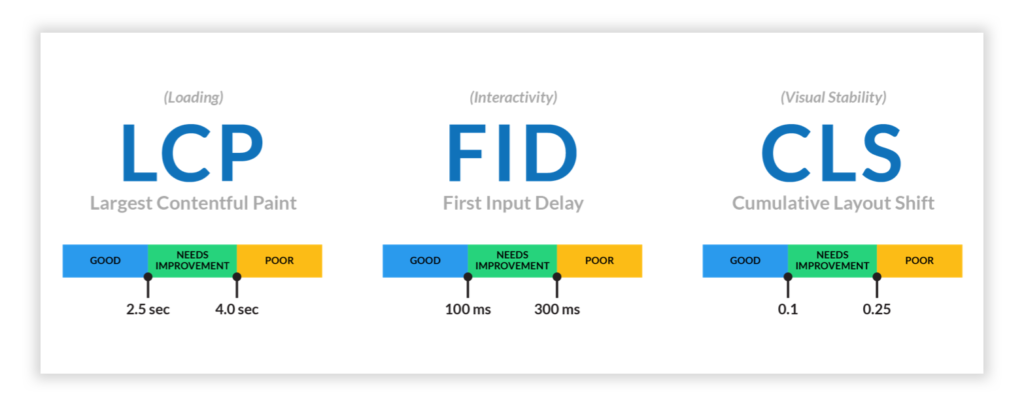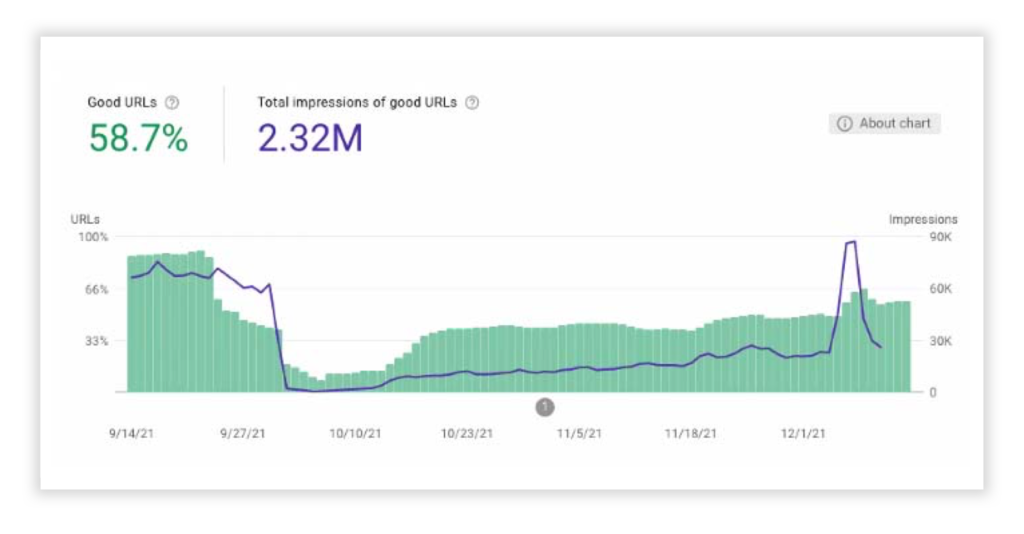Table of Contents
Search engine optimization (SEO) specialists and developers are like a hunting team. SEO is the pointer dog, developers take the shot. They can work well when paired together, but only if they’re on the same page. With Google’s recent focus on user experience as a ranking factor in its search algorithm, fewer pages meet the Google index criteria, and many websites are losing valuable organic search traffic. This is why it’s important for marketing leaders to invest in core web vitals SEO in 2022.
What are Google core web vitals?
While Google evaluates a given page for many factors, its search algorithm has recently started evaluating for user experience. Google will now grade each of your website’s pages based on how quickly they load, are responsive to users, and the visual stability of each page’s layout. There are three main core web vitals metrics to focus on improving:
- Largest Contentful Paint (LCP) — this measures how long it takes for the main content on a given page to load. For the best user experience, LCP should occur within 2.5 seconds. Loading times between 2.5 and 4 seconds needs improvement, while longer than 4 is considered very poor.
- First Input Delay (FID) — this measures how quickly a page will respond to an action taken by a user. Google views a good FID to be under 100 milliseconds. Times longer than 300 milliseconds are considered poor.
- Cumulative Layout Shift (CLS) — an important, user-centric metric used to measure visual stability. It helps quantify how often users experience unexpected layout shifts. These shifts are usually triggered by third-party content, dimensionless images, or other dynamic content. Quantified as a score, pages should maintain a CLS of less than 0.1.

The Google core web vitals and Google index relationship
Google’s search algorithm sends robots to websites to read, evaluate, and index pages. This is how they know where to place a given page in the results for certain queries. But scanning web pages takes time—and there are more pages added to the internet than Google’s bots have time to crawl. Google’s solution is to allocate a “crawl budget” to use its bots in the most effective way possible.
A “crawl budget” is the number of pages a robot crawls and indexes on a website within a given timeframe. If Google doesn’t index a page, it’s not going to rank in search results.
When you look at the Google index process, it gets interesting. If a page takes too long to load, a bot may skip the page and try again next time. If a page does not get crawled, it doesn’t get indexed, making it nearly invisible to organic search traffic.
It’s not technically a penalty for your site. Instead, Google is saying their bots’ time is more important than your page. But if you don’t address your page’s speed, you could be losing out on valuable search traffic.
The longest LCP load time I’ve run across is 22 seconds. That’s extraordinarily bad. Heck, just four seconds is bad. Twenty-two seconds is insane. You may think your website loads perfectly fine, but you might be surprised when you look at the data.
You can find out how good (or bad) your site’s core web vitals are by looking in Google Search Console for the number of pages that meet these criteria:
- Discovered, not indexed — Google knows the page exists, but didn’t crawl it due to crawl budget limitations
- Crawled, but not indexed — Google has crawled the page, but chosen not to index it.
What results can marketers expect from focusing on core web vitals?
The way search engines like Google factor core web vitals into their algorithms is still early in its maturity. We were lucky enough to do some proactive work on a client’s website in Q4 2021 and were pleasantly surprised with the results.
This business has both a retail and ecommerce presence. Some of its products cannot be purchased directly online, so the website acts as a showcase of sorts. Many of the website’s pages are product pages.
The company migrated their website to a new domain in September 2021. We used this as an opportunity to prioritize Google core web vitals rankings. At the onset of the new web domain, only about 10% of the page URLs were deemed “good” by Google. After implementation, we were able to hit nearly 60% “good” pages.

This led to a 25% increase in organic traffic in only a matter of months, including a healthy spike in December ahead of the 2021 holiday season. I joined the Digital Marketing Troop podcast to talk more in-depth about this case study. Listen here:
How much does Core Web Vitals SEO cost to implement?
If you have an in-house development team they’ll need to work hand-in-hand with your SEO specialist to identify the pages that need to be improved and what actions need to be taken. This can take valuable time and may take away from other development priorities.
Another solution is to outsource to a team of SEOs and developers who specialize in core web vitals SEO. The cost will vary depending on the size and current state of your website, number of pages that need to be updated, and specifically what needs to be done to each page.
Implementing core web vitals SEO for your website
The SEO and dev teams at Silverback Strategies work to implement core web vitals SEO solutions for clients as we continue to learn more about the major search algorithm update. If you’ve invested time and money developing content to be found in search results, addressing your core web vitals could be the final hurdle before reaching organic visibility. Contact us to request a Google core web vitals website audit today.


